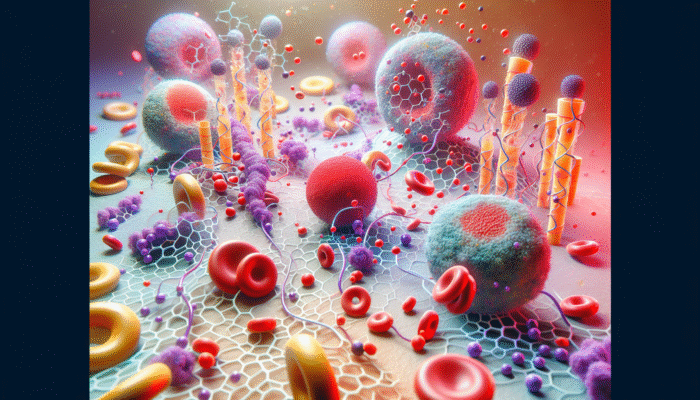Unlock the Vital Role of Nitric Oxide in Enhancing Blood Vessel Expansion
Diving Deep into the Mechanisms of Nitric Oxide Within the Human Body

Nitric Oxide and Blood Flow: nitric oxide (NO) is an indispensable molecule that plays a pivotal role in vasodilation, the physiological process that involves the widening of blood vessels. The intricate biochemical interactions that dictate the effects of nitric oxide on blood flow consist of a series of complex reactions. When released from endothelial cells that line the blood vessels, NO diffuses into adjacent smooth muscle cells, activating an enzyme known as guanylate cyclase. This activation results in increased levels of cyclic guanosine monophosphate (cGMP), which causes the relaxation of smooth muscle tissues. As these muscle fibers relax, the blood vessels expand, facilitating enhanced blood flow and diminishing vascular resistance. This crucial mechanism guarantees that organs and tissues receive sufficient blood supply, playing a fundamental role in regulating blood pressure.
Moreover, the importance of NO stretches well beyond its mere function of relaxing blood vessels. It operates as a fundamental signaling molecule that regulates a plethora of physiological processes, which include immune responses and neurotransmission. Nitric oxide plays a crucial role in maintaining the delicate equilibrium between vascular constriction and dilation, ensuring that the body’s tissues receive a steady supply of oxygen and nutrients while preventing undue pressure on the vascular walls. In essence, NO serves as a cornerstone in the preservation of cardiovascular health and the overall functionality of the body.
The Indispensable Role of Endothelial Cells in Promoting Cardiovascular Wellness
The endothelial cells that create the lining of blood vessels are tasked with producing nitric oxide, underscoring their critical importance in maintaining cardiovascular health. A well-functioning endothelium is essential for the release of adequate amounts of NO into the bloodstream. Various factors, including shear stress from blood flow, hormonal signals, and an array of biochemical stimuli, can significantly impact the production of NO. However, when the endothelium is compromised due to factors like inflammation, oxidative stress, or elevated cholesterol levels, its capacity to produce NO diminishes, leading to multiple cardiovascular challenges.
The relationship between endothelial function and blood flow is profound; a properly functioning endothelium generates higher levels of NO, enhancing the body’s capacity to respond to increased physical demands, especially during exercise. Conversely, when endothelial dysfunction occurs, it can hinder vasodilation, resulting in hypertension and a heightened risk of atherosclerosis. Research has demonstrated that improving endothelial function through lifestyle modifications, such as embracing a balanced diet rich in antioxidants and engaging in regular physical activity, can significantly boost nitric oxide production, thereby promoting overall cardiovascular health.
Delving into the Crucial Connection Between Nitric Oxide and Blood Pressure Regulation
The complex relationship between Nitric oxide and blood flow is intricately linked to the regulation of blood pressure. NO plays a foundational role in promoting vasodilation, which is essential for maintaining optimal blood pressure levels. High blood pressure, also known as hypertension, can lead to severe health complications, including heart disease and stroke. The ability of NO to relax blood vessels directly contributes to lowering vascular resistance, which facilitates smoother blood flow and reduces the heart’s workload.
Studies indicate that individuals with elevated levels of nitric oxide are more prone to experience lower blood pressure, further emphasizing this molecule’s significance in cardiovascular health. Additionally, therapeutic approaches aimed at increasing NO production, including specific medications or lifestyle changes, are commonly employed to manage and alleviate the effects of hypertension. This underscores the indispensable role of NO in supporting blood flow and protecting against the long-term ramifications of elevated blood pressure.
Exploring Dietary Sources to Enhance Nitric Oxide Levels

Integrating Nitrate-Rich Foods to Optimize Nitric Oxide Production
To effectively elevate nitric oxide levels in the body, one of the most practical approaches is to integrate a variety of nitrate-rich foods into your daily diet. Vegetables such as beets, spinach, and arugula are exceptionally abundant in nitrates, which the body can convert into NO. This conversion process initiates in the mouth and continues in the stomach, where beneficial bacteria assist in transforming nitrates into nitrites and ultimately into nitric oxide. Regularly including these foods in your meals not only enhances NO production but also fosters overall blood flow and bolsters cardiovascular health.
Globally, the consumption of nitrate-rich vegetables varies, with Mediterranean diets often emphasizing these nutritious options. Beets, for example, have gained immense popularity among athletes due to their potential to enhance performance through improved nitric oxide production. Furthermore, numerous cultures have long valued leafy greens in their culinary practices, recognizing the multitude of health benefits these nutrient-dense foods provide.
The role of dietary nitrates transcends simple supplementation; it highlights how a well-rounded and comprehensive dietary pattern can significantly influence cardiovascular function. Consistent consumption of nitrate-rich foods can lead to sustained increases in NO levels, thereby contributing to enhanced overall health and vitality.
Investigating Supplements to Boost Nitric Oxide Production
In addition to sourcing NO from dietary means, a plethora of supplements are available that can significantly augment nitric oxide production. Among the most sought-after are L-arginine and L-citrulline. L-arginine, an amino acid, acts directly as a precursor to NO, and its supplementation has been shown to improve blood flow and reduce blood pressure in certain populations. Conversely, L-citrulline is converted into L-arginine in the kidneys, providing a longer-lasting effect on nitric oxide levels.
These supplements have garnered popularity among athletes and fitness enthusiasts who aim to optimize performance and recovery. Research suggests that supplementation can enhance endurance, as the increased availability of NO aids in oxygen delivery to muscles during physical exertion. Moreover, for individuals facing cardiovascular challenges, these supplements may offer a natural alternative to pharmaceutical interventions aimed at increasing NO levels.
However, it is imperative to consult a healthcare professional before initiating any supplementation regimen, especially for those with pre-existing health conditions. Understanding the appropriate dosages and potential interactions with medications can help maximize the benefits of these nitric oxide boosters while ensuring safety.
Examining the Relationship Between Diet and Nitric Oxide Levels

Diet plays an essential role in influencing nitric oxide levels, with specific dietary patterns linked to enhanced NO production. Research supports the notion that a diet abundant in vegetables, particularly those high in nitrates, is an effective means to significantly boost NO levels. Incorporating a diverse range of fruits, vegetables, and whole grains ensures a comprehensive intake of nutrients that are vital for maintaining overall vascular health.
Furthermore, dietary antioxidants—found in foods such as berries, nuts, and dark chocolate—play a crucial role in protecting NO from degradation, thereby increasing its availability in the bloodstream. Antioxidants counteract oxidative stress, a known factor that hampers blood flow and diminishes NO bioavailability. The synergy between nitrates and antioxidants fosters an optimal environment for maintaining and elevating NO levels.
Globally, dietary habits vary, yet the principles of incorporating nitrate-rich and antioxidant-rich foods resonate across cultures. For instance, Mediterranean diets rich in ingredients like olives, nuts, and leafy greens promote NO production and enhance overall health. Engaging in mindful eating practices that prioritize whole, natural foods can be a powerful strategy for individuals aiming to enhance their cardiovascular health through nutrition.
Harnessing Antioxidant-Rich Foods to Sustain Nitric Oxide Levels
Foods abundant in antioxidants play a crucial role in promoting and preserving nitric oxide levels in the body. Once NO is synthesized, it can be readily degraded by free radicals—unstable molecules responsible for oxidative damage. By including foods high in antioxidants in your diet, individuals can mitigate this degradation, allowing for a more sustained presence of NO in the bloodstream.
Berries like blueberries and strawberries are excellent sources of antioxidants, particularly flavonoids, which have been shown to enhance the bioavailability of nitric oxide. Nuts, especially walnuts and almonds, provide essential fatty acids and vitamins that support cardiovascular health. Dark chocolate, rich in flavonoids, serves as another delightful option that promotes NO production while offering numerous health benefits.
Incorporating a variety of these antioxidant-rich foods into daily meals not only promotes healthy blood flow but also provides a protective mechanism against various diseases. A well-balanced diet that celebrates the richness of global culinary traditions can serve as a powerful ally in enhancing nitric oxide levels and supporting overall vascular health. By recognizing the significance of nitrates and antioxidants, individuals can take proactive steps toward improving their cardiovascular wellness through thoughtful dietary choices.
Leveraging Exercise to Amplify Nitric Oxide Production
Identifying Effective Workouts to Boost Nitric Oxide Levels
Engaging in regular physical activity stands out as one of the most effective methods to naturally increase nitric oxide levels in the body. Different types of exercises can induce varying degrees of NO production, with aerobic activities such as running, cycling, and swimming being particularly advantageous. These exercises elevate heart rate and enhance blood circulation, resulting in increased shear stress on endothelial cells, which subsequently stimulates NO release.
High-intensity interval training (HIIT) also serves as a formidable method for boosting NO production. This exercise form alternates between short bursts of intense activity and periods of rest or lower-intensity exercise. The dynamic nature of HIIT not only enhances cardiovascular fitness but also improves endothelial function, leading to better blood flow and overall cardiovascular health.
Globally, the popularity of various exercise regimes illustrates the universal importance of physical activity in promoting health. Whether through group cycling classes in urban settings or community running events in rural areas, the focus on exercise as a means to enhance nitric oxide production transcends cultural boundaries. Encouraging regular physical activity is a vital strategy for individuals seeking to improve their health and well-being.
Understanding How Exercise Intensity and Duration Influence Nitric Oxide Production
The intensity and duration of exercise play a significant role in influencing nitric oxide production. Research demonstrates that moderate to high-intensity workouts are most effective in boosting NO levels. When individuals engage in vigorous exercise, the body’s oxygen demand escalates, prompting more NO production to facilitate enhanced blood flow to working muscles. This effect is especially significant for athletes and individuals involved in competitive sports, as improved oxygen delivery can enhance performance and endurance.
Duration also plays a crucial role; prolonged exercise sessions can lead to sustained increases in NO production. Studies have indicated that maintaining physical activity for a minimum of 30 minutes can significantly boost NO levels, resulting in improved recovery and cardiovascular advantages. Striking a balance between intensity and duration is essential to maximize the positive effects of exercise on nitric oxide production.
Globally, individuals from diverse backgrounds can benefit from understanding the relationship between exercise and NO levels. Whether participating in traditional dance forms, martial arts, or contemporary fitness classes, the principles of intensity and duration are universally applicable. Cultivating a culture of physical activity that emphasizes these factors can enhance health outcomes across various populations.
Long-Term Benefits of Regular Exercise on Nitric Oxide Production and Cardiovascular Wellness
Consistent engagement in physical activity can lead to enduring increases in nitric oxide levels, contributing to lasting cardiovascular health benefits. Over time, regular exercise not only enhances endothelial function but also promotes structural changes in blood vessels, allowing them to respond more effectively to the body’s demands. This adaptive process supports sustained improvements in blood flow and overall cardiovascular efficiency.
Furthermore, long-term exercise is associated with a reduced risk of chronic diseases such as heart disease, hypertension, and diabetes. As individuals become more physically active, their bodies establish a higher baseline level of NO production, which protects against vascular dysfunction. The positive feedback loop created by regular exercise facilitates ongoing health improvements, reinforcing the importance of adopting an active lifestyle.
In various cultures worldwide, physical activity is celebrated as a form of community engagement that fosters a collective approach to health and well-being. Whether through organized sports, group workouts, or traditional physical activities, the significance of long-term exercise can serve as a cornerstone of public health initiatives aimed at enhancing cardiovascular health on a global scale.
Connecting Nitric Oxide to Heart Health and Disease Prevention
The Protective Role of Nitric Oxide in Heart Disease Prevention
The profound connection between nitric oxide and cardiovascular health becomes especially evident in the context of heart disease prevention. Elevated levels of NO are linked to a decreased risk of conditions such as atherosclerosis, heart attacks, and strokes. NO is essential for preserving endothelial function, which regulates blood flow and prevents plaque accumulation in the arteries.
Research indicates that individuals with adequate NO levels typically exhibit healthier blood vessels, which are crucial for preventing heart disease. The vasodilatory effects of NO enhance circulation and contribute to lowering blood pressure, further diminishing the risk of cardiovascular events. Implementing lifestyle modifications that promote NO production, such as a nutritious diet, regular exercise, and effective stress management, can serve as proactive strategies for heart disease prevention worldwide.
Raising awareness about the significance of NO in cardiovascular health can be a vital component of community health education programs. By emphasizing simple lifestyle adjustments that can enhance NO levels, public health initiatives can empower individuals to take control of their heart health, ultimately contributing to a reduction in the prevalence of heart disease globally.
Utilizing Nitric Oxide Therapies for Effective Hypertension Management
Therapeutic approaches targeting nitric oxide have emerged as promising strategies for managing hypertension, a condition affecting millions globally. Elevated blood pressure often results from impaired endothelial function and reduced NO production. Interventions aimed at increasing NO levels can provide practical solutions for individuals grappling with hypertension.
Medications designed to release NO or enhance its signaling pathways are currently under investigation and have shown positive outcomes in clinical settings. Moreover, lifestyle interventions such as dietary modifications and exercise can complement these therapies, providing a holistic approach to hypertension management. Combining NO-boosting strategies can lead to significant improvements in blood pressure control, thereby reducing the risk of related complications.
Globally, hypertension is often referred to as a silent killer, underscoring the urgent need for awareness and intervention. Community-based initiatives that educate individuals on the role of NO in blood pressure regulation can empower them to adopt healthier lifestyles, ultimately fostering better cardiovascular health outcomes.
Exploring Nitric Oxide’s Role in Atherosclerosis Prevention
Atherosclerosis, characterized by plaque buildup in the arteries, poses a significant threat to cardiovascular health. Nitric oxide plays a protective role in preventing the progression of this condition. By promoting vasodilation and enhancing blood flow, NO helps maintain healthy circulation and minimizes the likelihood of plaque formation.
Additionally, NO exhibits anti-inflammatory properties that help alleviate the inflammatory processes contributing to atherosclerosis. By decreasing oxidative stress and improving endothelial function, adequate NO levels can inhibit the initial stages of plaque development and promote overall vascular health.
Addressing atherosclerosis globally necessitates a multifaceted approach, including dietary changes, regular physical activity, and awareness of cardiovascular risk factors. Understanding the protective role of nitric oxide can guide public health strategies aimed at reducing the incidence of atherosclerosis and improving long-term cardiovascular outcomes.
Enhancing Blood Flow Through Nitric Oxide Production
One of the most significant advantages of nitric oxide production is the enhancement of blood flow. Through its vasodilatory effects, NO facilitates increased blood flow to various tissues and organs, ensuring they receive the oxygen and nutrients necessary for optimal function. This is particularly critical during physical activity when the demand for oxygen rises, necessitating improved circulation.
In addition to exercise, numerous factors such as hydration, nutrition, and lifestyle choices can influence nitric oxide levels and blood flow. Individuals who prioritize these factors may experience enhanced exercise performance, quicker recovery times, and overall better health. Raising global awareness of these principles can help foster healthier communities, encouraging individuals to adopt practices that enhance nitric oxide production and promote optimal blood circulation.
Moreover, improved blood flow has implications that extend beyond physical performance; it also plays a vital role in cognitive function. Enhanced circulation supports brain health by ensuring adequate oxygen and nutrient delivery, which can contribute to overall cognitive performance and well-being.
How Nitric Oxide Safeguards Against Heart Failure
The protective effects of nitric oxide against heart failure are well-documented, with higher levels of NO associated with improved heart muscle function. By promoting vasodilation and enhancing blood flow, NO reduces the workload on the heart, making it an essential factor in managing and preventing heart failure.
NO’s ability to decrease oxidative stress and inflammation is crucial in protecting heart health. Studies indicate that individuals with higher NO levels often exhibit better heart function and lower rates of heart failure. This highlights the importance of maintaining adequate NO levels through lifestyle interventions such as a healthy diet, regular exercise, and stress reduction techniques.
Globally, heart failure is an increasing concern, necessitating a concerted effort to raise awareness about lifestyle factors that can influence NO production. Community education programs emphasizing the importance of cardiovascular health and the protective effects of nitric oxide can empower individuals to take proactive steps toward preventing heart failure.
Investigating the Impact of Nitric Oxide on Athletic Performance
Maximizing Endurance Through Nitric Oxide Elevation
The influence of nitric oxide on athletic performance, particularly endurance, is substantial. Enhanced NO production improves oxygen delivery to muscles during exercise, enabling athletes to perform at higher intensities for longer durations. This increased efficiency benefits endurance activities such as long-distance running and cycling, while also enhancing overall athletic performance across diverse sports.
Research has shown that supplementation with nitric oxide boosters, such as L-citrulline and beetroot extract, can enhance time-to-exhaustion during endurance tasks. The advantages of NO extend beyond mere performance enhancements; they also facilitate faster recovery and reduce muscle soreness, allowing athletes to train more effectively and consistently.
Athletes from various disciplines worldwide recognize the benefits of incorporating NO-enhancing foods and supplements into their training regimens. From elite competitors to weekend warriors, understanding the role of nitric oxide can help individuals maximize their athletic potential and achieve their performance goals.
Facilitating Muscle Recovery with Nitric Oxide
Muscle recovery is crucial for athletic performance, and nitric oxide plays a vital role in this process. By enhancing blood flow to muscles post-exercise, NO promotes the delivery of oxygen and nutrients necessary for recovery. This improved circulation aids in clearing metabolic waste products, such as lactic acid, which can contribute to muscle soreness and fatigue.
Studies have indicated that athletes who maintain adequate NO levels may experience faster recovery times and reduced muscle soreness following intense workouts. This allows them to return to training sooner and perform at their best. Additionally, NO’s anti-inflammatory properties can further support the healing process, making it a valuable ally for athletes seeking to optimize their recovery.
Globally, the emphasis on recovery as an integral part of athletic training is gaining traction. Athletes and fitness enthusiasts increasingly recognize the importance of supporting nitric oxide production to enhance recovery. By prioritizing nutrition, hydration, and appropriate supplementation, individuals can set themselves up for success in their athletic pursuits.
The Rising Popularity of Nitric Oxide in Sports Supplements
The demand for nitric oxide boosters in sports supplements has surged in recent years, as athletes seek to enhance their performance and recovery. Many pre-workout products now contain ingredients aimed at increasing NO production, such as L-arginine, L-citrulline, and beetroot extract. These components work synergistically to promote vasodilation, improve blood flow, and enhance athletic performance.
A growing body of research supports the benefits of NO supplementation, highlighting its potential to improve endurance, increase strength, and accelerate recovery. Athletes across various sports disciplines leverage these supplements to gain a competitive edge, making them a staple in numerous training regimens.
As the global sports industry continues to evolve, the demand for effective supplements targeting nitric oxide production is likely to increase. Education surrounding the proper use of these supplements is essential to ensure athletes understand the benefits and potential risks associated with their use. By fostering a culture of informed supplementation, individuals can enhance their performance while prioritizing their health and well-being.
Nitric Oxide Production and the Aging Process
The Decline of Nitric Oxide Production with Advancing Age
As individuals age, the natural production of nitric oxide tends to decrease, significantly affecting vascular health and overall well-being. This age-related decline in NO production is commonly associated with various health conditions, including hypertension, cardiovascular diseases, and cognitive decline. The endothelial cells become less efficient at generating NO, resulting in compromised vascular function and impaired blood flow.
Research has shown that this reduction in NO levels may contribute to the increased prevalence of age-related diseases. A decrease in NO availability hampers blood vessels’ ability to dilate, leading to elevated blood pressure and a higher risk of atherosclerosis. Understanding this decline underscores the importance of proactive health measures to sustain NO levels as individuals age.
Globally, increasing awareness of the effects of aging on NO production can inspire community health initiatives focused on promoting healthy lifestyles. Encouraging regular physical activity, balanced nutrition, and effective stress management can empower individuals to take proactive steps to mitigate the effects of aging on nitric oxide levels.
Effective Strategies for Sustaining Nitric Oxide Levels as You Age
To counteract the age-related decline in nitric oxide levels, individuals can adopt various lifestyle strategies aimed at enhancing NO production. Engaging in regular physical activity, particularly aerobic exercises, has been shown to stimulate NO release and improve endothelial function. Additionally, strength training can promote muscle health and overall cardiovascular fitness.
Dietary modifications are also critical in maintaining adequate NO levels. A diet rich in nitrate-containing vegetables, antioxidants, and healthy fats can support NO production while protecting against degradation. Staying hydrated is essential for optimal vascular function and nitric oxide synthesis.
Globally, promoting healthy aging can be integrated into public health campaigns that emphasize the importance of physical activity and nutrition in maintaining nitric oxide levels. By fostering a culture of wellness that prioritizes these factors, communities can work together to improve health outcomes for aging populations.
The Connection Between Nitric Oxide Levels and Longevity
Research indicates that higher nitric oxide levels may contribute to increased longevity and enhanced quality of life. The protective effects of NO against cardiovascular diseases, inflammation, and oxidative stress play a significant role in promoting long-term health. By supporting vascular function and maintaining adequate blood flow, NO helps reduce the risk of chronic diseases that can negatively affect life expectancy.
Moreover, individuals who prioritize a lifestyle that enhances NO production, through regular exercise, a balanced diet, and healthy habits, are likely to experience improved overall well-being and vitality as they age. This holistic approach to health can significantly influence longevity, enabling individuals to enjoy their later years with greater health and independence.
Initiatives aimed at promoting healthy aging can have profound implications for public health on a global scale. By raising awareness about the importance of nitric oxide in longevity, communities can empower individuals to take proactive steps toward enhancing their health and well-being as they age.
The Impact of Nitric Oxide on Cognitive Function in Older Adults
Maintaining adequate nitric oxide levels is crucial for supporting brain health and cognitive function, especially as individuals age. NO is vital in neurotransmission and communication between neurons, affecting various cognitive processes such as memory and learning. The decline in NO production associated with aging may contribute to cognitive impairment and an increased risk of neurodegenerative diseases.
Research indicates that enhancing NO levels through lifestyle modifications, such as diet and exercise, can positively affect cognitive function. Improved blood flow to the brain facilitates the delivery of oxygen and nutrients, which are vital for optimal brain health. Additionally, NO’s neuroprotective properties may help shield brain cells from oxidative stress and inflammation.
Globally, promoting understanding of the relationship between nitric oxide and cognitive health can lead to community initiatives focused on brain health. By encouraging individuals to adopt lifestyle practices that enhance NO production, communities can work together to support cognitive vitality and reduce the risk of age-related cognitive decline.
Exploring Therapeutic Interventions for Enhancing Nitric Oxide Levels
Therapeutic interventions aimed at boosting nitric oxide levels offer promising potential for addressing age-related declines. Supplements like L-arginine and L-citrulline have gained attention for their ability to enhance NO production, and research continues to explore their effectiveness in improving health outcomes within aging populations. Additionally, medications targeting nitric oxide pathways are being investigated for their potential benefits in treating age-related diseases.
Combining these therapeutic approaches with lifestyle modifications can create a comprehensive strategy for maintaining NO levels and supporting overall health. By fostering a culture of awareness regarding the importance of nitric oxide in aging, communities can empower individuals to take charge of their health, leading to improved quality of life and longevity.
Understanding the Connection Between Nitric Oxide and Mental Health
Unpacking Nitric Oxide’s Contribution to Brain Function and Health
Nitric oxide is increasingly recognized for its role in brain function and mental health. As a signaling molecule, NO is involved in neurotransmitter regulation and communication between neurons, which is critical for various cognitive processes, including mood regulation, learning, and memory. Maintaining adequate NO levels contributes to overall brain health and can substantially impact emotional well-being.
Research has shown that impaired NO signaling may be associated with mood disorders such as depression and anxiety. Maintaining sufficient NO levels can positively influence mental health by promoting healthy blood flow to the brain and enhancing neurotransmitter function. This highlights the importance of lifestyle factors—such as nutrition and exercise—in supporting NO production and, by extension, brain health.
Globally, mental health awareness is gaining traction, and understanding the role of nitric oxide in cognitive function can inform public health initiatives. By promoting strategies that enhance NO levels, communities can contribute to improved mental health outcomes for individuals of all ages.
The Interconnection Between Nitric Oxide, Mood, and Stress Management
The relationship between nitric oxide and mood is intricate. Research indicates that adequate NO levels can aid in managing stress and enhancing overall emotional well-being. NO’s ability to facilitate blood flow and support neurotransmitter function is crucial in regulating mood. Individuals with higher NO levels may experience reduced anxiety and greater mood stability.
Lifestyle practices that enhance NO production, such as regular exercise, a balanced diet rich in nitrates, and effective stress management techniques, can improve mental health. These practices not only support NO levels but also promote overall wellness, fostering a holistic approach to mental health care.
Globally, the emphasis on mental well-being highlights the necessity for community support systems that promote health education and awareness. By underscoring the connection between nitric oxide and mood regulation, communities can empower individuals to prioritize their mental health and adopt proactive strategies for enhancing emotional well-being.
Potential Therapeutic Benefits of Nitric Oxide in Mental Health Disorders
Emerging research suggests that nitric oxide may play a role in treating various mental health disorders. Its involvement in neurotransmitter regulation indicates potential therapeutic applications for conditions such as depression and anxiety. Studies exploring the effects of NO modulation on mental health have shown promising results, suggesting that enhancing NO production may help alleviate symptoms in certain patients.
Understanding the potential of NO in mental health treatment opens up avenues for innovative therapeutic interventions. As research continues to evolve, integrating NO-boosting strategies into mental health care could provide valuable tools for enhancing treatment outcomes.
Addressing mental health issues globally requires a multifaceted approach. By fostering awareness of the role of nitric oxide in mental health, communities can work towards reducing stigma and promoting effective treatment options. Collaborative efforts that combine education, research, and community support can significantly improve mental health outcomes for individuals worldwide.
Frequently Asked Questions About Nitric Oxide
What is nitric oxide, and why is it essential for health?
Nitric oxide is a signaling molecule in the body that plays a crucial role in vasodilation, improving blood flow, and regulating blood pressure. It is vital for cardiovascular health and overall bodily function.
How can I naturally increase my nitric oxide levels?
Incorporating nitrate-rich foods like beets and spinach, exercising regularly, and adding supplements such as L-arginine and L-citrulline to your routine can boost nitric oxide levels.
Which foods are high in nitrates?
Beets, spinach, arugula, celery, and kale are among the foods richest in nitrates. These vegetables are excellent for promoting nitric oxide production in the body.
Is nitric oxide beneficial for athletes?
Nitric oxide enhances oxygen delivery to muscles, improving endurance and recovery. Many athletes use NO boosters to enhance performance during training and competition.
Can nitric oxide help lower blood pressure?
Yes, nitric oxide dilates blood vessels, which helps lower vascular resistance and regulate blood pressure, making it a crucial factor in managing hypertension.
What is the relationship between nitric oxide and aging?
As individuals age, nitric oxide production decreases, impacting cardiovascular health and cognitive function. Maintaining NO levels through diet and exercise is vital for healthy aging.
How does exercise affect nitric oxide production?
Regular physical activity enhances nitric oxide production by increasing the demand for blood flow. Aerobic exercises, in particular, are effective in boosting NO levels.
Can nitric oxide improve mental health?
Yes, adequate nitric oxide levels are associated with better mood regulation and cognitive function. NO may play a role in managing stress and alleviating symptoms of mental disorders.
Are there risks associated with nitric oxide supplementation?
While nitric oxide supplements can offer benefits, consulting a healthcare professional before starting any supplementation regimen is crucial to ensure safety and proper dosage.
How does diet influence nitric oxide levels?
A diet rich in nitrate-containing foods, antioxidants, and healthy fats can enhance nitric oxide levels, supporting vascular health and overall well-being.
Connect with us on Facebook!
The Article Nitric Oxide and Blood Flow: Enhancing Circulation appeared first on https://athleticsupplement.com
The Article Nitric Oxide Boosts Blood Flow for Improved Circulation Was Found On https://limitsofstrategy.com


Your exploration of the role of nitric oxide (NO) in enhancing blood vessel expansion brings to light an often overlooked but vitally important aspect of cardiovascular health. As someone keenly interested in biochemistry and its implications for our well-being, I appreciate the depth you’ve provided in explaining the mechanistic pathways involved in vasodilation.